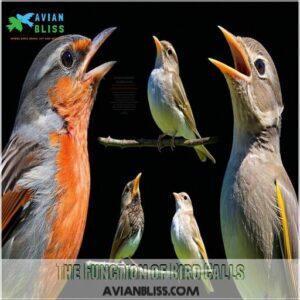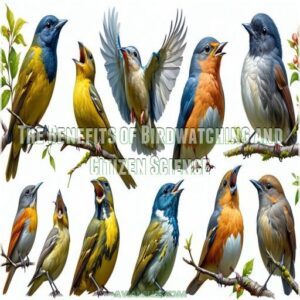This site is supported by our readers. We may earn a commission, at no cost to you, if you purchase through links.

Birds use a complex language of sounds that goes way beyond simple chirping.
Their calls serve critical survival functions – from warning about predators to maintaining flock coordination. You’ll hear alarm calls that instantly mobilize entire groups, soft contact calls keeping family members connected, and intricate songs advertising territory and attracting mates.
Different species develop unique vocal signatures shaped by their environment, with calls ranging from piercing warnings to melodic symphonies.
Understanding these feathered conversations reveals a world of communication more nuanced than you might imagine.
Table Of Contents
- Key Takeaways
- The Function of Bird Calls
- Characteristics of Bird Songs
- Bird Communication Methods
- The Role of Vocalizations in Mating
- Identifying Birds Through Vocalizations
- Visual Communication in Birds
- Inter-Species Communication in Birds
- The Significance of Bird Communication
- Observing Bird Behavior for Insights
- The Benefits of Birdwatching and Citizen Science
- Frequently Asked Questions (FAQs)
- What is a bird call?
- How do birds communicate with each other?
- What do bird calls convey?
- What do contact calls help birds to do?
- How do birds use calls to communicate food location?
- Why do birds use alarm calls?
- Can birds learn new communication sounds?
- How do baby birds develop calls?
- Do birds communicate differently in cities?
- Why do some birds mimic sounds?
- Conclusion
Key Takeaways
- You’ll discover that bird calls are sophisticated survival tools, serving critical functions like warning about predators, maintaining flock coordination, and signaling food locations.
- Each bird species develops unique vocal signatures, with calls ranging from piercing alarm signals to melodic songs that communicate territory, health, and mate attraction potential.
- Birds communicate through multiple channels beyond just sound, including visual displays, body language, chemical signals, and tactile interactions that reveal complex social dynamics.
- By understanding bird communication, you’ll gain insights into intricate ecological interactions, with their calls acting as living sensors that broadcast information about environmental conditions and potential threats.
The Function of Bird Calls
Have you ever wondered how birds communicate using their calls, turning the sky into a complex network of vocal messages?
You’ll discover that bird calls serve as critical survival tools.
Helping feathered friends warn of danger, maintain contact with their flock, and navigate the challenges of their daily lives.
Types of Calls
Ever wondered how birds chat without words?
Bird calls are nature’s messaging system, serving different purposes across species.
These avian vocalizations range from short, sharp contact calls that help birds stay connected to quick, precise food calls signaling meal locations.
Each type of bird call is a specialized communication tool, packed with information about location, safety, and survival strategies.
The avian vocalizations are a complex system.
Alarm Calls Vs Contact Calls
Bird communication relies on alarm calls and contact calls that serve distinct purposes to keep feathered friends safe and connected.
Alarm calls blast loud, sharp warnings about nearby predators, triggering immediate group responses.
Softer contact calls, by contrast, maintain flock cohesion, helping birds track each other’s locations and coordinate movements with barely a whisper.
Role in Foraging and Migration
Alarm calls morph into strategic signals during foraging and migration, helping flocks navigate complex challenges.
These specialized bird communication patterns guide groups through treacherous landscapes, pinpointing food sources and warning against predators.
Precise calls maintain group cohesion, allowing birds to share critical location information while protecting themselves from potential threats during long migration routes.
Call Variations Across Species
Because communication is more than just chirping, bird calls showcase remarkable variations across species that’ll blow your mind. These vocal masterpieces reflect intricate evolutionary strategies.
- Species develop unique call complexity based on habitat
- Geographic dialects emerge in closely related populations
- Call functions adapt to specific environmental challenges
- Interspecies communication reveals sophisticated recognition patterns, such as the "alarm call network" that rapidly responds to predator threats detected.
- Acoustic signals evolve to maximize survival advantages
Birds don’t just talk—they strategically communicate survival secrets.
Characteristics of Bird Songs
You’ll discover that bird songs are more than just pleasant melodies; they’re complex communication tools.
birds use them to attract mates and defend territories.
These intricate vocal performances vary by season, species, and individual, revealing a fascinating world of feathered conversations.
Melodic Patterns and Complexity
From simple chirps to intricate symphonies, bird songs showcase remarkable musicality variations that’ll blow your mind. Their song structure reveals nature’s hidden complexity evolution. Some birds craft melodies so sophisticated, they make Mozart proud.
Birds also use their complex songs for territorial defense and mate attraction, showcasing their health and strength to potential mates and rivals.
| Bird Species | Song Complexity | Emotional Impact |
|---|---|---|
| Nightingale | Extremely High | Deep Wonder |
| Mockingbird | Moderate | Playful Delight |
| Canary | Low | Gentle Calm |
| Lyrebird | Extraordinary | Pure Amazement |
Acoustic adaptations prove these feathered musicians are true communication maestros.
Seasonal Variations in Song Activity
Winter’s hush doesn’t silence every bird’s melody.
Seasonal shifts dramatically alter bird songs, with breeding season intensity peaking in spring and summer.
During molting, many species reduce vocal output, conserving energy.
Geographic differences play a role, as migration influences singing patterns.
Some birds maintain winter songs, revealing the complex rhythms of avian communication through changing landscapes.
Territorial Advertising and Mate Attraction
As song complexity ramps up during breeding season, birds transform into nature’s most passionate performers. Their acoustic signals become powerful tools for mate attraction and territory defense.
- Males belt out intricate bird songs to showcase fitness
- Unique dialect variations catch potential mates’ attention
- Loud, clear melodies signal genetic superiority
- Duet singing demonstrates pair bonding
- Strategic call placement defines territorial boundaries
These feathered vocalists turn their world into a magnificent concert hall.
Bird Communication Methods
You’ll be amazed at how birds communicate through more than just chirps and tweets.
From vibrant visual displays to intricate vocal patterns, birds have developed a complex communication system.
complex communication system that helps them survive, find mates, and navigate their environments.
Vocal Communication
Building on the melodic complexity of bird songs, vocal communication emerges as a powerhouse of avian interaction.
Birds produce a symphony of calls, from soft contact chirps to piercing alarm signals.
These acoustic adaptations reveal intricate communication strategies, showcasing how feathered friends use bird calls to navigate their world, sharing critical information about danger, territory, and connections.
Visual Communication
Listen up, bird enthusiasts!
After hearing bird calls, you’ll notice their visual communication speaks volumes.
Plumage patterns and displays reveal complex messages birds share.
Courtship shows off bright colors, while threat postures make birds look massive.
Body language tells a story – from feather ruffling to wing positioning – that’s way more than just a pretty picture in the avian world.
Chemical Signaling
While visual signals catch your eye, birds have another secret weapon: chemical signaling. Their scent glands whisper messages invisible to human perception. Chemical cues play a subtle role in avian interactions, revealing intricate communication strategies.
- Pheromone use enables species recognition
- Olfactory communication guides social behavior
- Chemical signals mark territories discreetly
- Scent conveys complex emotional states
These microscopic messengers reveal a hidden world of bird communication beyond what meets the eye. Chemical cues and avian interactions are explored.
Tactile Communication
Beyond scent signals, birds forge deeper connections through tactile communication.
Bill rubbing and preening reveal intricate social bonds, showcasing affection and maintaining feather health.
Nesting pairs strengthen their relationship through gentle touches, while allopreening helps remove parasites and reinforces social connections.
Birds also display affection through beak rubbing, which can be a sign of beak health maintenance.
These intimate avian interactions demonstrate the complexity of bird body language beyond mere vocalization.
The Role of Vocalizations in Mating
You’ll be amazed at how birds use their songs to win mates and defend territories, turning their melodic calls into powerful tools of attraction.
By understanding these intricate vocal performances, you’ll uncover how a bird’s song reveals its health, genetic fitness, and potential as an exceptional partner.
Song Learning and Development
Building on bird communication methods, song learning reveals a fascinating world of vocal plasticity. Young birds don’t just chirp randomly—they carefully absorb and mimic sounds from their environment.
- Genetic blueprints guide initial song structures
- Parent birds provide critical vocal templates
- Social interactions shape complex vocal patterns
- Age influences song complexity and refinement
- Environmental sounds contribute to song development
Their musical journey transforms raw potential into melodic mastery.
Mate Selection and Territorial Defense
After mastering complex songs, male birds deploy powerful vocal strategies for mate selection and territorial defense.
Their melodic performances aren’t just music—they’re strategic broadcasts showcasing genetic fitness and claiming prime real estate.
Research on bird mating calls highlights their role in advertising a bird’s suitability as a mate.
Vocal duets and aggressive displays communicate territory size, with louder, more intricate songs signaling superior health and attracting potential mates in the competitive bird world.
Vocalizations as Indicators of Health
When birds belt out their songs, they’re actually broadcasting their fitness report card.
Vocal range and sound clarity reveal more than just melody – they signal genetic quality and health status.
Robust bird calls with consistent frequency showcase a bird’s prime condition, making their vocalizations a natural fitness tracker that potential mates can’t help but notice.
Identifying Birds Through Vocalizations
You’ll be amazed at how bird calls can help you identify different species, turning your backyard into an auditory wildlife guide.
With the right techniques and modern technology like audio recordings and smartphone apps, you’ll soon recognize birds by their unique sounds, even before you spot them.
Birding by Ear Techniques
Bird-call detectives, sharpen your ears and gain access to the symphonic world of avian communication! Mastering birding by ear requires dedication and a keen sense of listening.
Utilize a bird call identifier app to enhance your skills.
- Train your brain to distinguish subtle pitch variations
- Practice mimicking bird calls in different environments
- Learn the unique vocal signatures of local species
- Learn muscle memory for recognizing sound patterns
Mastering birding by ear, bird call identifier app, avian communication
Audio Recordings and Apps for Identification
Modern bird identification apps transform your smartphone into a portable ornithological laboratory.
These cutting-edge tools leverage sound accuracy algorithms to analyze audio clips, matching bird calls against extensive digital libraries.
With intuitive user interfaces and thorough species coverage, these apps empower birders to instantly recognize feathered friends, whether online or offline, turning every nature walk into an exciting discovery mission.
Regional Dialects in Birdsong
If you’ve ever wondered why birds sound different across regions, you’re tuning into the fascinating world of bird song dialects.
Geographic influences shape bird vocal dialects, creating unique communication patterns.
White-crowned sparrows, for instance, have distinct song variations across California, revealing how cultural transmission and local environments impact bird communication, making each chirp a linguistic fingerprint of its homeland.
Visual Communication in Birds
You’ve likely seen birds fluffing their feathers or striking dramatic poses without realizing they’re communicating complex messages through visual signals.
These intricate displays serve critical functions in courtship, territorial defense, and threat communication, revealing a sophisticated language beyond mere appearance.
Plumage and Coloration as Signals
After listening to bird calls, you’ll notice their plumage speaks volumes too.
Color mutations and iridescent feathers aren’t just pretty—they’re powerful communication tools.
Sexual dimorphism reveals nature’s clever design, where bright colors signal health and attract mates.
Camouflage techniques demonstrate how birds use plumage to blend in or stand out, turning their feathers into a complex visual language.
Displays and Postures in Courtship and Threat
Birds step up their visual communication game through dramatic displays and postures during courtship and territorial defense.
Their body language speaks volumes – from puffed-up feathers signaling aggression to elaborate mating dances that showcase fitness.
These intricate bird communication rituals help potential mates assess genetic quality and warn off rivals, turning every interaction into a high-stakes visual performance. Visual communication is crucial for courtship and territorial defense.
Passive Visual Communication
Involuntary displays reveal nature’s hidden language, where birds unconsciously communicate through subtle body language.
Plumage patterns and cryptic coloration become silent messengers, broadcasting essential information without intention.
These passive visual cues expose health, genetic fitness, and environmental adaptations, telling stories birds never meant to share. Your keen eye can decode these unintentional signals of bird communication.
Additionally, the phenomenon of plumage coloration plays a significant role in revealing a bird’s overall health and fitness. Plumage coloration, bird communication, and passive visual cues are key concepts.
Inter-Species Communication in Birds
You’ll discover how birds communicate beyond their own species, using sophisticated warning signals and threat displays that bridge biological boundaries.
These remarkable inter-species communication strategies reveal a complex world of avian interaction that helps birds survive and thrive in diverse environments.
Alarm Calls and Warning Signals
When feathered friends spot danger, their alarm calls become a lifeline of survival. Predator alerts spread like wildfire through flocks, warning companions of potential threats.
- Rapid, high-pitched sounds travel quickly
- Specific call types identify different predators
- Intensity varies with threat level
- Calls trigger immediate defensive responses
- Cross-species communication saves lives
Birds use these alarm calls as part of their overall vocal and visual signals.
These deceptive calls can mean the difference between life and death in the wild.
Agonistic Interactions and Threat Displays
Birds display a dramatic world of aggression through intricate threat displays and agonistic interactions.
Puffing feathers, spreading wings, and adopting menacing postures, they communicate dominance without physical combat.
Ritualized fights establish pecking orders, with loud calls and strategic positioning serving as powerful defensive tactics in the high-stakes drama of bird social behavior.
Birds also use specific bird threat calls to deter predators and competitors from their territory. This is a key defensive tactic. Threat displays and calls are common. The pecking order is established through ritualized fights.
Communication Across Species Boundaries
Beyond territorial skirmishes, feathered friends share surprising communication networks.
Interspecies alarm calls ripple through forests, with different bird species warning each other about predators.
Some birds even mimic other species’ sounds, creating complex symbiotic signals that transcend traditional communication boundaries.
These vocal learning strategies reveal a sophisticated, interconnected world of avian dialogue that keeps entire ecosystems alert and alive.
The Significance of Bird Communication
You’ll be amazed at how birds use complex communication strategies to survive and thrive in their intricate social worlds.
Their calls and songs aren’t just random sounds, but sophisticated communication tools that help them navigate everything from finding a mate to warning their flock about approaching predators.
Survival and Reproduction
From the intricate dance of alarm calls between feathered friends, we uncover how bird communication drives survival and reproduction.
Mating rituals emerge through complex vocalizations, where parental care and chick survival hinge on precise warning signals.
These sophisticated calls reveal nature’s delicate balance, where each sound can mean the difference between life and continuation of the species.
Observing bird language patterns, such as the "Bird Sit" technique Bird Language Basics, can help humans better understand the intricate dynamics of bird communication and behavior.
Territorial Defense and Resource Acquisition
In the intricate world of bird communication, territorial defense plays a vital role in survival. Birds employ sophisticated strategies to protect their domains and resources through intricate vocal competitions.
- Loud, distinctive calls marking boundaries
- Strategic positioning near resource-rich areas
- Aggressive vocal displays to intimidate rivals
- Complex song patterns signaling strength
- Rapid response to potential territorial threats
Mastering these defense mechanisms guarantees survival and resource acquisition in the competitive avian landscape.
Social Dynamics and Flock Behavior
Beneath the rhythmic flutter of wings, birds weave intricate social tapestries through sophisticated communication.
Flock cohesion emerges from carefully orchestrated communication roles, where hierarchy structures guide predator response and foraging strategies.
Their social dynamics reveal a complex network of bird social behavior, with each chirp and wing-flick broadcasting critical information that fosters survival and group harmony.
Observing Bird Behavior for Insights
When you watch birds closely, you’ll uncover a world of hidden communication.
This reveals their complex social interactions and survival strategies.
By paying attention to their calls, postures, and behaviors, you’ll gain fascinating insights.
These insights show how these feathered creatures navigate their environment and interact with each other.
Understanding Interactions and Social Dynamics
Watching birds reveals intricate social dynamics that mirror human interactions.
Flock behavior unfolds like a complex dance, where bird hierarchies and cooperation levels shape every interaction.
Social learning happens through nuanced communication, with territorial behavior and conflict resolution strategies playing out in real-time.
By observing these feathered societies, you gain insight into the intricacies of their rich social world.
Awareness of Environmental Cues
By tuning into bird calls, you’ll uncover a world of environmental signals.
Each chirp and tweet offers insights into habitat selection and weather patterns.
Birds become living sensors, broadcasting key information about predator movements, foraging opportunities, and ecosystem changes.
Their acoustic landscape reveals intricate details about surrounding conditions that even sophisticated technology might miss. Bird calls provide valuable information.
Implications for Human Safety
Understanding bird behavior can be your secret weapon for staying safe in the wild. Their sharp instincts reveal hidden risks, helping you navigate unfamiliar environments with heightened awareness.
As birds broadcast critical warnings about potential threats, you’ll learn to interpret their alarm calls like a pro.
- Recognize bird distress calls signaling immediate danger
- Identify predator proximity through specific vocalization patterns
- Decode habitat safety indicators from bird behavior
The Benefits of Birdwatching and Citizen Science
When you engage in birdwatching, you’re not just enjoying nature—you’re becoming a valuable contributor to scientific research and conservation efforts.
By participating in citizen science projects, you’ll help researchers track bird populations, understand migration patterns, and protect our feathered friends’ habitats.
Contributions to Ornithological Research
Citizen scientists act as vital data collectors in ornithological research, transforming bird call analysis through advanced acoustic studies.
Their contributions to bioacoustics help researchers track song dialects, population dynamics, and bird vocalizations across diverse environments.
By systematically documenting bird communication patterns, amateur researchers provide invaluable insights that professional ornithologists might otherwise miss.
Promoting Ecological Awareness and Conservation
By tracking bird populations through citizen science projects, you’re not just watching—you’re becoming a guardian of our ecosystems.
Your observations help scientists map habitat changes, understand climate impacts, and develop conservation strategies.
Every bird call recorded, every migration pattern noted, becomes a powerful tool in protecting wildlife and preserving our planet’s delicate ecological balance.
Health and Well-being Through Birding
Step into birding and discover a treasure trove of wellness benefits.
Observing bird communication can reduce stress, boost mental clarity, and forge a deeper nature connection.
From tracking bird calls to understanding vocalizations, this gentle physical activity offers more than exercise—it’s a gateway to community building and personal rejuvenation through feathered friendships.
By incorporating bird identification techniques, such as recognizing bird calls and songs through tools like Merlin Sound ID, birdwatchers can enhance their connection with nature.
Frequently Asked Questions (FAQs)
What is a bird call?
Like a messenger whisking secret signals across treetops, a bird call is a quick, sharp vocalization.
It helps birds communicate immediate needs.
Birds also use calls to warn of danger, or maintain contact with their flock.
How do birds communicate with each other?
You’ll find birds communicating through a symphony of vocal calls, visual displays, and body language.
They share warnings, attract mates, and mark territories using complex sounds and movements.
Scientists are still unraveling these complex sounds and movements.
What do bird calls convey?
Bird calls signal essential survival information like danger warnings, food locations, and social connections.
They’re nature’s quick-response communication system.
Helping birds stay alert, coordinate movements, and protect their flock from potential threats in real-time.
What do contact calls help birds to do?
Like secret whispers in nature’s playground, contact calls help birds stay connected with their flock, sharing location, maintaining group cohesion, and signaling safety during foraging, migration, and daily survival activities.
How do birds use calls to communicate food location?
You’ll discover that birds use short, distinctive calls to alert flock mates about food sources.
with specific chirps indicating type, quantity, and location,
helping group members quickly find and share essential nutrition.
Why do birds use alarm calls?
Birds use alarm calls to warn their flock about potential predators.
These piercing sounds help other birds quickly detect and escape imminent threats.
group survival is ensured by rapidly communicating danger across their immediate environment.
Can birds learn new communication sounds?
Curiously enough, some bird species become linguistic artists, learning and mimicking new sounds throughout their lives, from regional dialects to complex songs that evolve during migration and social interactions.
How do baby birds develop calls?
You’ll hear baby birds mimic their parents’ sounds through innate vocal learning, practicing calls from birth.
They gradually develop complex vocalizations by listening, repeating, and refining their communication skills throughout early developmental stages.
Do birds communicate differently in cities?
In urban environments, birds adapt their calls to be louder and higher-pitched, cutting through city noise.
They modify communication strategies, creating unique dialect variations.
These dialect variations help them survive and thrive amid metropolitan soundscapes.
Why do some birds mimic sounds?
Sound’s symphony dances through a bird’s world, where mimicry serves as a survival strategy.
By copying sounds, birds attract mates, defend territories, confuse predators, and showcase their intelligence through acoustic adaptability.
Conclusion
Ready to decode the secret world of bird communication calls?
You’ve just scratched the surface of an incredible domain where every chirp, tweet, and song tells a story.
By understanding these feathered conversations, you’ll gain insights into survival strategies, social dynamics, and the remarkable intelligence of our avian friends.
Next time you hear birds chattering, listen closely—they’re sharing a complex language that’s been millions of years in the making.
- https://birdfact.com/bird-behavior/communication/calls-and-songs
- https://www.hummingbirdsplus.org/nature-blog-network/birds-communicate-songs-calls-and-body-language/
- https://pubmed.ncbi.nlm.nih.gov/23446529/
- https://www.allaboutbirds.org/news/look-out-the-backyard-bird-alarm-call-network/
- https://animals.howstuffworks.com/birds/can-bird-species-talk-with-each-other.htm

















